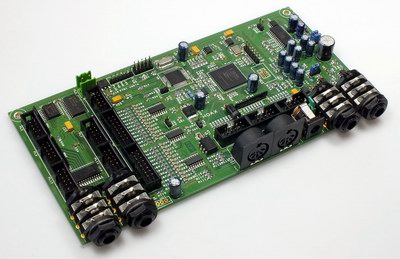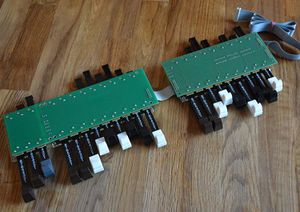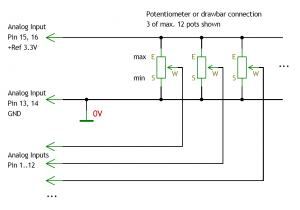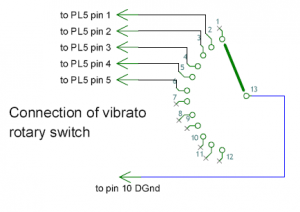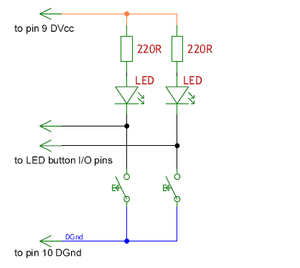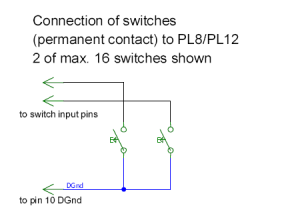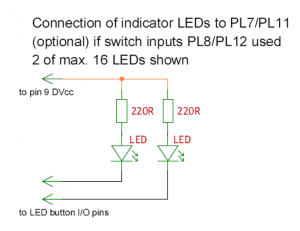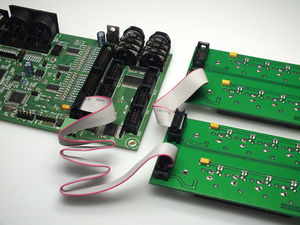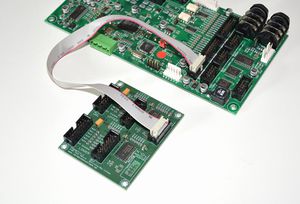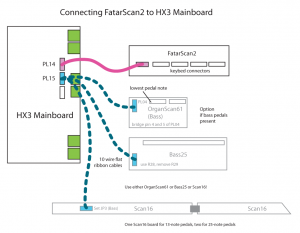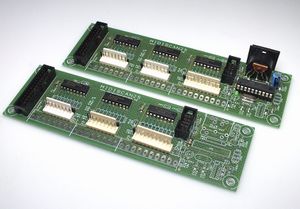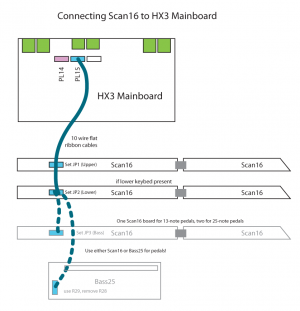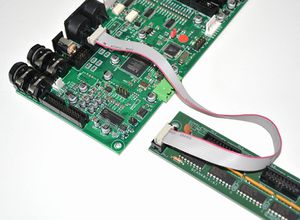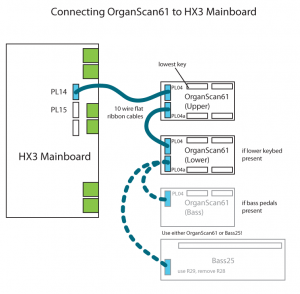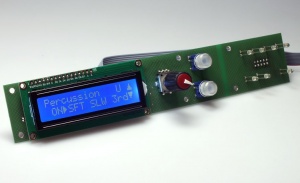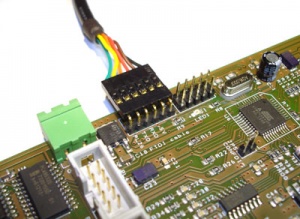HX3 Board Installation
HX3 single-board sound engine for connecting any keyboard, for installation into existing organs or MIDI control
Installation
Requirements
HX3 should be installed by a qualified technician only. You should be familiar with ribbon cable mounting, crimp contact installation and soldering of delicate parts. Important: Boards contains static sensitive components. Be sure to use anti-static tools and grounded soldering toolset.
HX3 board has standard firmware and licences installed from factory. However, you have to configure it to your own needs with HX3 Remote Application (drawbar and potentiometer enables and routing, scan board used). In some cases, you have to upload a special firmware (for latching presets, single manual organs or use of older Preset 24 board). You will need the USB adaptor cable, the HX3 Extension board or an USB interface to configure or update the HX3 board.
First Steps
Connect PL2 power connector to +5V stabilized DC supply, capable of at least 300mA. Be sure not to swap polarity; follow silk print on circuit board! You may alternatively use a wall wart type 5V supply with jumper JP12 (near DC jack) installed or 9 to 12V with jumper JP12 removed. Voltage regulator must be mounted to small heat sink for the latter case on older mk2 and mk3 boards. PL2 must not be used with external power applied to DC jack. Overvoltage or interchanged polarity will destroy HX3 circuitry. On new HX3 mk4 boards, 9-12V DC input is also available on PL2. Use either 5V or 9-12V input for supply. Remove jumper JP12 (near DC jack) when using 9-12V DC input.
After connecting power, LED1 (red) should light up for a few seconds, subsequentially followed by LED2 (yellow) flickering. If LED1 (red) blinks fast for a while or LED2 (yellow) does not light up, FPGA image data in flash memory has been tampered or is corrupted. Please return HOAX to manufacturer for repair or re-install firmware and FPGA configuration. Flickering or "breathing" yellw LED2 shows that HX3 sound engine (FPGA configuration) is working.
For normal operation, jumper JP6 (on mk2 boards), jumper REF (on mk3 boards) or JP9 (on mk4 boards) must be inserted, despite JP12 for 5V operation of DC jack. Remove jumpers JP7 and JP8.
Use AGND and DGND pins as a "jumper rest" for spare jumpers. Switch off before connecting anything else.
You may omit those switches/connections/drawbars/pots you don’t plan to use. Analog inputs (drawbars/pots) should be tied to ground or to fixed level (use of trimpot) if not used, otherwise they will "float" and change sound randomly, even with preset active.
HX3 may also be used without any switches/drawbars/pots connected by selecting "No Analog Inputs" in HX3 Remote parameter 478 (Expander Mode) - see page Using HX3 with MIDI controllers. You may leave all internal connectors open if you plan to remote by MIDI only with analog control inputs disabled.
Only connect/disconnect cables or optional boards when power is off!
Please refer to board placement diagrams (*_silk) in our Github repository, directories PLATINEN (PCBs) and DOCS_PDF. Also visit HX3 mk3/mk4 additional info page for mk2/mk3/mk4 differences.
Older HX3 mk2 Boards
Older mk2 boards differ in serveral ways from current production, although board size, connector positions, FPGA configuration and Scan Core (parts of firmware package) are compatible. HX3 mk2 boards do not have a 26-pin header for extension boards. Otherwise, they have 4 audio output channels already on board, routed to two stereo jacks.
2-way jumper JP6 on older mk2 boards sets MAIN/BASS output jack either to MONO or to 2-channel output (separate pedal bass on plug ring). Set JP6 to 2-CHANNEL (opposite to MONO) to use newer firmware. JP12 disables internal 5V voltage regulator for use with 5V power supplies on DC jack. Remove JP12 if using 9 to 12V power on DC jack. When ordered as kit, the "HW Test" scan core is still active and a full "C" chord should appear on organ main and Leslie audio outputs. If OK, change scan core with HX3 Remote.
HX3 mk2 had separate tab stop switch inputs and button inputs. On mk3/mk4, button inputs alternatively act as switch inputs with appropiate ButtonMask setting in HX3 Remote. See "Connecting Digital Inputs" section for details.
HX3 mk2 boards require a different controller firmware, not compatible with mk3/mk4. Be sure to use "HX3mk2_*.hex" files when updating your mk2 board with HX3 Remote.
Connecting Analog Inputs
HX3 provides 24 analog inputs, all located on pin headers PL9 and PL13. All analog inputs are DC controlled. Input voltage range is from 0V (off or minimal volume) to +3.3V (max. volume). HX3 may also be used without any switches/drawbars/pots connected by installing the MIDI Expander firmware. You may leave all internal connectors open if you plan to remote by MIDI only with analog control inputs disabled. Note: One analog input is internally tied to SWELL jack and should remain open.
Connecting Drawbar 9/11/12 Boards
Connection to our drawbar boards Drawbar9 and Drawbar12 is very simple: Drawbar9 (upper) connects to PL9, Drawbar12 (lower) connects to PL13 via 16-wire flat ribbon cable (length up to 1m, plugs wired 1:1). Drawbar9 provides 3-pin headers for connection of Tone and Amp122 Volume pots; may be disabled by HX3 Remote parameter 481 if adusted by MenuPanel. Additional Drawbar9-MPX boards may be inserted for "two drawbar sets per manual" configurations. Note that Drawbar9-MPX must be the right drawbar set for each manual as on Hammond Consoles (see picture).
Drawbar9 and Drawbar11/12 are compatible and interchangeable, despite additional drawbars for bass pedals resp. tone/amp volume.
Note to HX3 mk2/mk3 users: Older HX3 boards do not provide a drawbar set switching signal for Drawbar 9-MPX on Pin 15 of PL9 and PL13. From firmware #3.925 and up, switching signals are provided on vibrato knob port PL5 (otherwise unused) pin 6 (upper manual drawbars) and pin 7 (lower). You have to route two single wires from these pins to each PL43 of Drawbar9-MPX (middle pin).
Connecting other Drawbar Pots
You may also use your own or existing drawbars as follows: At least connect 9 drawbars or slider pots and Leslie volume control pot to PL9 Analog upper. R value should be in the 10 kOhm to 47 kOhm range, linear taper (for example type B10K). Note that using audio taper (log.) drawbar pots as found in various older LSI and transistor organs will not yield correct loudness and drawbar position on MenuPanel display.
From firmware revision 3.7 up there are special versions for use in single drawbar set organs. In this case, drawbars must be connected to PL13 (Lower). Single drawbar set is assigned automatically to manual (or split section) which is currently played (or was used last). On PL9, only input pins 10 and 11 are used (Tone und Amp Volume; may be disabled by HX3 Remote parameter 481 if adusted by MenuPanel).
PL9 Analog Controller A (Upper Manual)
Pin - function
1: Drawbar 16
2: Drawbar 5 1/3
3: Drawbar 8
4: Drawbar 4
5: Drawbar 2 2/3
6: Drawbar 2
7: Drawbar 1 5/9
8: Drawbar 1 1/3
9: Drawbar 1
10: Aux/Tone Pot
11: Amp Pot, simulated rotary tube amp volume
12: Swell Pedal (do not connect if swell jack used)
13, 14: Drawbar/Pot common Ground
15: Drawbar set A/B switch signal (mk3/mk4 boards only; may be tied to pin 16)
16: Drawbar/Pot End 3.3V+ (Reference)
PL13 Analog Controller B (Lower Manual)
Pin - function
1: Drawbar 16
2: Drawbar 5 1/3
3: Drawbar 8
4: Drawbar 4
5: Drawbar 2 2/3
6: Drawbar 2
7: Drawbar 1 5/9
8: Drawbar 1 1/3
9: Drawbar 1
10: Drawbar Bass 16
11: Drawbar Bass 8
12: Drawbar/Pot Bass Sustain
13, 14: Drawbar/Pot common Ground
15: Drawbar set A/B switch signal (mk3/mk4 boards only; may be tied to pin 16)
16: Drawbar/Pot End 3.3V+ (Reference)
DC swell/volume control is active also on pin 12 of PL9. Even with MIDI control, a swell pedal should be connected to SWELL jack. This overrides MIDI volume control. You may connect a swell pedal like Yamaha FC-7 or a simple volume pot to the SWELL jack. Do not connect pin 12 of PL9 if swell jack used.
HX3 mainboard is set to tone/treble and amp volume control inputs active by factory (may be altered also with HX3 Remote or MenuPanel). Tone pot center is connected to pin 10 of PL9. If digital Leslie emulation is licenced on HX3, pin 11 becomes the Leslie amp volume/drive control (mandatory). Amp volume pot center is connected to pin 11 of PL9. Both pots begin with Gnd and end with Ref 3.3V+.
Please note: Open analog inputs (unconnected) will "float" and change randomly, even with presets active. Tie unused inputs to ground or fixed level (ie. trimpot).
Connecting Digital Inputs
HX3 mk3/mk3 provides 16 digital inputs plus one rotary swich input. Switches are defined as tab stops, rocker or toggle switches, buttons are momentary switch contacts, normally open. All inputs are active low, i.e. tie to ground when switch/button is operated.
Panel 16
Easiest solution for a register/stop panel is using our Panel 16 board connected to PL7 and PL11 by two 10-wire flat ribbon cables. Panel 16 provides 16 buttons for complete HX3 control; just add the rotary switch for vibrato depth.
Panel 16 has 4 "Common Preset" buttons, common to upper and lower manual. They may be used as buttons selecting V1-V3 vibrato or C1-C3 Chorus depth by updating your HX3 to "Button Vibrato" (_btnvib) firmware. In this case, omit the vibrato rotary switch.
Panel 16 PCB may be cut along "CUT HERE" line to get separate sections with 8 buttons each.
Other Buttons or Switches
Instead of Panel 16 you may also connect your own buttons or tab switches (up to 16). Every function is activated by either a button on digital inputs PL7/PL11 or a switch on PL8/PL12 (mk2 only). A momentary contact to ground on each PL7/PL11 pin will toggle it's status and drive indicator LEDs (see schematic). Leave unused digital inputs open.
Newer mk3 and mk4 boards do not provide additional switch inputs. To use tab stop switches on mk3/mk4 boards, define PL7 and PL11 inputs as switches with HX3 Remote Application, "Organ defaults" parameter page. Check boxes in "ButtonMask" parameter row 479 and 480 to define an input pin as a switch instead of a button. The rightmost check box represents Pin 1 and so forth, up to leftmost box for pin 8. When using buttons, an indicator LED should be installed as shown; otherwise there is no indication if a tab stop is on or off.
For mk2 boards, Pin functions of PL8/PL12 are equivalent to PL7/PL11, but provide separate tab stop switch inputs. Strictly use PL7/PL11 as button/LED inputs and PL8/PL12 as switch inputs with same functionality. Parameters 479 and 480 are invalid here.
Vibrato/chorus V1 to C3 is selected by a rotary switch:
Pinout PL5 Vibrato rotary switch
Pin - function (active low – switch to Gnd)
nc: Vib1 (no connection)
1: Cho1
2: Vib2
3: Cho2
4: Vib3
5: Cho3
6: not used
7: not used
8: MEM LED- (optional)
9: MEM LED+ (optional)
10: Common Gnd
Four "Common Preset" inputs (common to upper and lower manual) on PL11 may be used as buttons selecting V1-V3 vibrato or C1-C3 Chorus depth by updating your HX3 to "Button Vibrato" (_btnvib) firmware. In this case, omit the vibrato rotary switch.
Pinout PL7 buttons (momentary contact, optional LED) or PL8 tab/rocker switches on mk2 boards
Pin - function (active low – switch to Gnd)
1: Perc ON, like B3
2: Perc SOFT
3: Perc FAST
4: Perc THIRD
5: Vib ON upper
6: Vib ON lower
7: Leslie ON (connected LED blinks with Leslie speed)
8: Leslie FAST
9: (+5V, used only for button LEDs supply, e.g. on Panel16)
10: Common Gnd
Pinout PL11 buttons (momentary contact, optional LED) or PL12 tab/rocker switches on mk2 boards
Pin - function (active low – switch to Gnd)
1: Common Preset 1 (only button on PL11 - do not use pin 1 of PL12!)
2: Common Preset 2 (only button on PL11 - do not use pin 2 of PL12!)
3: Common Preset 3 (only button on PL11 - do not use pin 3 of PL12!)
4: Common Preset 4 (only button on PL11 - do not use pin 4 of PL12!)
5: EFX 1 / Reverb 1
6: EFX 2 / Reverb 2
7: Bass on Leslie (routes pedal bass also to Leslie simulation if ON)
8: Split ON
9: (+5V, used only for button LEDs supply, e.g. on Panel16)
10: Common Gnd
Connecting Presets
HX3 board does provide 4 "common" presets (see Pinout PL11) for both upper and lower manual. It may be extended to 2x8, 2x12 or 2x16 presets with optional boards Preset 12 (obsolete), Preset 12-2, Preset 16 (one or two) or Preset 24 (obsolete). All connect to HX3 PL4 by 10-wire flat ribbon cable. HX3 PL4 is a I2C bus system, so all boards connect in parallel (use multiple 10-pin plugs on one cable if necessary); Preset12 and Preset16 yield an extension route-through connector for adding more boards. Cable length on HX3 PL4 should not exceed 75 cm (30") in total. Use appropriate firmware for each preset solution. See description of each product for details. Obsolete boards are still supported by newer firmware issues.
Preset 16
Preset 16 is a self-contained panel with 2 rows of 8 LED buttons each. It connects to HX3 PL4 by a 10-wire flat ribbon cable. A second Preset 16 may be connected to second 10-pin header (daisy-chain). Both 10-pin headers on Preset16 may be used (are wired in parallel). A jumper set on Preset 16 selects upper manual. If jumper is absent, Preset16 works on lower manual.
If only one Preset 16 is connected, jumper JP1 must be set. Now upper row of buttons is for upper manual, lower row for lower manual (i.e. 8 presets each). This preset split function may be overridden by param 484 in HX3 Remote set to ON.
If using 2 sets of drawbars per manual by DB9-MPX drawbar board board, set HX3 Remote "Organ Defaults" parameter 483 "2nd Drawbar Set" to 1. This will activate 1st drawbar set on Preset 0, 2nd drawbar set on Preset 1.
Preset 12-2
Preset 12-2 is an interface board for up to 2 x 12 "inverted" preset keys (with optional LED indicators) as found on Hammond console organs. Preset 16 PCB is similar to Panel 16, but has additional circuitry and connects to HX3 PL4 by a 10-wire flat ribbon cable. See schematics for pin designation. Pin 1 of both 14-pin headers is Preset 0 = Live (right drawbar set) = B key, pin 2 is Preset 1 = Live (left drawbar set) etc. downto pin 12 = CANCEL key.
Standard organ firmware supports momentary contacts. To save a preset, press and hold preset key/button for 2 seconds.
For latching keys (original Hammond keybeds), use "Latching" type firmware. Save a preset by pressing CANCEL key (i.e. Preset 11) and then destination preset key, hold both for 2 seconds and release CANCEL.
If using 2 sets of drawbars per manual by DB9-MPX drawbars/multiplexer and Preset12-2 board, set HX3 Remote "Organ Defaults" parameter 483 "2nd Drawbar Set" to 1.
Pinout PL1 (LEDs)
Pin - function
1: LED 1 cathode (Preset 0, "B" key drawbar set)
2: LED 2 cathode (Preset 1, "A#" key drawbar set)
3: LED 3 cathode (Preset 2)
...
12: LED 12 cathode (Preset 11, CANCEL key)
13,14: Common LED anode (+)
LED outputs have on-board 220 Ohms resistors, resulting in 15 mA LED current. Long leg of LEDs is anode (+), short leg is cathode (-).
Pinout PL2 (Buttons/Switches)
Pin - function (active low – switch to Gnd)
1: Switch 1 (Preset 0, "B" key drawbar set)
2: Switch 2 (Preset 1, "A#" key drawbar set)
3: Switch 3 (Preset 2)
...
12: Switch 12 (Preset 11, CANCEL key)
13,14: Common switch ground (0V)
Note: The old Preset12-MPX boards for HX3 mk2/mk3 may be used as well for HX3 mk4 and mk5. They do not offer a variable preset number for second drawbar set, though. Instead, second drawbar set is hard-wired to Voice Preset 15. So you have to change 2nd drawbar set number in parameter #1496 (HX3.5) resp #496 (HX3.4) to 15, not to 1.
Connecting Keyboard Scan Board(s)
For lowest key-to-audio latency we recommend direct keyboard connection via scan board (different versions available). Use HX3 Remote application, "Organ Defaults" parameter 477 to set appropriate scan board driver (so called Scan Core) for board used. However, HX3 may be controlled by MIDI key ON/OFF messages from any keyboard by using Scan Core 1 (MIDI input) without any scan board connected.
Scan Cores will support MIDI input/output too, but for MIDI remote we recommend MIDI input driver as this one has the most versatile transposing and octave shifting features, supporting the full range of 88 key manuals.
FatarScan2
A single FatarScan2 board is connected to HX3 PL14. One or two Fatar 61 key manuals (type TP/8O or similar) may be connected to one FatarScan2 board using a special cable set (MicroMatch connectors to keyboard scanning strips). See page Anschluss der Scan-Platine FatarScan2 (german) for more pictures. We recommend buying the FatarScan2 cable set for connection to MicroMatch headers on Fatar keybeds (one set for each manual).
Bass pedals may be connected to an additional Scan16-Strip, Scan61-Inline or Bass25 board wired to HX3 PL15 (!). FatarScan2 board is are activated by HX3 Remote application, "Organ Defaults" parameter 477.
Bass25
Bass25 scan board (refer to PDFs in our Github repo folder PLATNEN/BASS25) may be used as an addition to FatarScan2, OrganScan61, Scan61-Inline and Scan16-Strip boards for convenient connection of bass pedal contacts as pictured above (note different HX3 headers). Board may be placed in bottom of organ if 10-wire flat ribbon cable to HX3 or last OrganScan61 board does not exceed 1m. Please note jumper setting on Bass25:
Old version (beige PCB):
- JP6 inserted always
- JP7 2-3 inserted if OrganScan61 (daisy chain on HX3 PL14), Bass25 to last OrganScan61 board
- JP7 1-2 inserted if FatarScan2 on HX3 PL14, or Scan16 Strip and Bass25 to HX3 PL15
- JP8 2-3 inserted always
Contacts always switch to ground (busbar).
New version MIDISCAN25 (green PCB):
- JP1 solder bridge, always open
- JP2 solder bridge if used with OrganScan61 (daisy chain on HX3 PL14), Bass25 to last OrganScan61 board
- JP3 solder bridge if used with FatarScan2 on HX3 PL14 or Scan16 Strip on HX3 PL15
Bass25 provides in-line headers and a 26-pin flat ribbon cable connector for alternative connection of bass pedal contacts:
Pin - function (active low – switch to Gnd)
1: Lowest note "C"
...
25: Highest note "C"
26: Common ground (busbar)
JP3 and JP4 solder bridges must be closed. 2-pin inline header PL9 also provides common ground for the busbar.
Note: A third Scan16-Strip or Scan61-Inline board may alternatively be used for bass pedal instead of Bass25, using only the first 13 or 25 contact inputs. Set jumper JP3 on scan boards to enable them for bass pedal use.
Bass25 MIDI
Bass25 MIDI is equipped with an own MIDI controller and MIDI output jack. It is connected to HX3 mk3/mk4 main board by 5-wire MIDI cable. Bass25 MIDI provides in-line headers and a 26-pin flat ribbon cable connector for alternative connection of bass pedal contacts. 2-pin inline header PL9 also provides common ground for the busbar.
Pin - function (active low – switch to Gnd)
1: Lowest note "C"
...
25: Highest note "C"
26: Common ground (busbar)
JP3 solder bridge must be closed.
JP4 solder bridge must be closed if Bass25 MIDI is powered by phantom supply from HX3 board, left MIDI input jack (seen from back). MIDI phantom power jumpers on HX3 board must be inserted (mk3 and mk4 boards only).
For separate power supply (internal +5V or external 9V DC wall wart), open JP4 solder bridge. Use 2-pin header PL12 next to MIDI OUT jack to supply internal +5V: Pin 1 (left, facing towards diode) is VCC +5V, pin 2 (right) is ground (refer to PDF schematics in our Github repo folder PLATNEN/BASS25).
A +5V MIDI phantom supply on outer pins of MIDI input may be obtained from HX3 mainboard by inserting two additional jumpers on HX3 PL10 pins 7-8 and 9-10. Do not install these jumpers if connecting other MIDI gear not using a phantom supply.
Scan16-Strip Set
As an alternative to old OrganScan61 one or two sets of tall Scan16-Strip boards (one set for each manual) may be used which yield easier installation on some keybeds. For each manual you need 3 (44 or 49 keys) or 4 (61 keys) Scan16 boards. Please refer to schematics and part placement in out Git repo. All Scan16 equipped manuals are wired in parallel with one 10-wire flat ribbon cable (multiple connectors attached) to HX3 PL15. Bass25 may be used as pedal scan board. A jumper on "lowest" Scan16 board determines if keybed is upper, lower or bass pedal:
JP1 = Upper manual
JP2 = Lower manual
JP3 = Pedal notes
Please note: lowest key contact pad on Scan16 is always "C" key on 4- and 5-octave keybeds. On 61-key manuals, upper part of rightmost Scan16 board may be cut off as marked on PCB silk screen printing (or pads are left open). On 44-key manuals, lowest 5 pads are left open, manual(s) start with "F" key. On 49-key manuals, connect pad PL20 to highest "C" note. All contacts must switch to ground. Boards provide ground lugs for connection to busbar.
Scan16 boards for one or two 49/61-key manuals is are activated by HX3 Remote application, "Organ Defaults" parameter 477.
Scan61-Inline
Scan61-Inline works exactliy like a Scan16-Strip set of 4 PCB, but has all parts mounted on one compact PCB (one Scan61-Inline needed for each manual). So each key must be wired separately. Please refer to schematics and part placement in out Git repo. All Scan61 equipped manuals are wired in parallel with one 10-wire flat ribbon cable (multiple connectors attached) to HX3 PL15. Bass25 may be used as a third pedal scan board. A jumper on Scan61-inline board determines if keybed is upper, lower or bass pedal:
JP1 = Upper manual
JP2 = Lower manual
JP3 = Pedal notes
Please note: lowest key contact pad on Strip61-Inline is always "C" key. On shorter manuals, leave unused key inputs open. As on OrganScan61 or Scan16-Strip, all contacts must switch to ground. Boards provide ground lugs for connection to busbar.
Scan61-Inline boards are activated by HX3 Remote application, "Organ Defaults" parameter 477, set to Scan16/61.
OrganScan61 Board Set
Obsolete, for reference only!
A set of up to 3 "daisy-chained" OrganScan61 boards are connected to PL14 if HOAX was ordered with OrganScan61 firmware driver. Refer to picture. Be shure not to twist connectors (red marked ribbon lead must match with pin 1 of all ribbon cable connectors, indicated by a triangle marking). Total cable length should not exceed 1,5m. First board in row is upper manual, second is lower manual and third (rightmost in picture) is bass pedal (not completely populated since only 25 keys are present). Bass25 board may be used as an alternative to last OrganScan61 board; it has the same functionality (but different key connectors). See page Anschluss der Scan-Platine OrganScan61 (KlangComputer) (german) for more pictures.
Inputs are active low (switch to ground), so connecting them to Gnd pins 13 to 16 of PL33 (PL31 on bass) on OrganScan61 board should yield the appropriate note. See OrganScan61 schematic for connector pinout.
Keybed Connection
Plug/Pin - function (active low – switch to Gnd)
PL30/1: Note 1 = lowest C 1
PL30/16: Note 16 = D# 2
PL31/1: Note 17 = E 2
PL31/16: Note 32 = G 3
PL32/1: Note 33 = G# 3
PL32/16: Note 48 = H 4
PL33/1: Note 49 = C 5
PL33/16: Note 61 = C 6
PL33/14,15,16: Gnd/Busbar
Pedals Connection
(or use Bass25 scan board)
Plug/Pin - function (active low – switch to Gnd)
PL30/1: Note 1 = lowest C 1
PL30/16: Note 16 = D# 2
PL31/1: Note 17 = E 2
PL31/9: Note 25 = C 2
PL31/14,15,16: = Gnd/Busbar
OrganScan61 boards are activated by HX3 Remote application, "Organ Defaults" parameter 477.
Firmware Settings
Firmware type depends on preset board used and number of manuals. Factory default is Preset16/Preset12-2 standard organ firmware, two keybeds with drawbar set for each manual. Update your HX3 with HX3 Remote Application to different firmware if using a single drawbar set (no lower manual), latching preset keys or Preset24. Even with correct firmware installed, there are some settings that have to be done with HX3 Remote. All parameters can be found in HX3 Remote's Organ defaults tab:
Parameter - Function
438/439 - Output Jack Configuration Routes 5 different signals to 2 (or 4 with extension board) audio output jacks (32 variants).
477 - Scan Core Set to scan board used in yout organ or to sole MIDI input.
478 - No Analog Inputs Set to ON (255) if no pots or drawbars connected. Drawbars are controlled by MIDI only.
479 - ButtonMask Pins PL7 Check boxes for each PL7 pin that is connected to a switch instead of a button (applies to mk3 and mk4 boards).
480 - ButtonMask Pins PL11 Check boxes for each PL11 pin that is connected to a switch instead of a button (applies to mk3 and mk4 boards).
481 - AMP Pot Enable When OFF, HX3 simulated rotary tube amp volume is controlled by MIDI or MenuPanel only. Set to ON (255) if simulated rotary amp is controlled by potentiometer on pin PL9 pin 11.
492 - AUX Pot Routing When OFF, HX3's TONE and MASTER VOLUME functions are controlled by MIDI or MenuPanel only. Set to 1 to route Aux analog input (PL9 pin 10) to TONE function. Set to 2 to route input to MASTER VOLUME function (firmware 3.925 and up).
483 - 2nd DBs Preset Number Default 16 (no second drawbar set per manual). Set to 1 if using Preset 16 or Preset 12-2 and two drawbar sets per manual with drawbar boards Drawbar 9/12 plus Drawbar 9-MPX. Set to 15 if using old Preset 24 or Preset 12 MPX boards.
Options
MenuPanel
Our MenuPanel allows convenient adjustments of various HX3 parameters to tweak your setup. Two versions available, short one without indicator LEDs intended for organ installation.
Connect HX3 MenuPanel to HX3 PL4 using a 10-wire flat ribbon cable. HX3 firmware from version 3.41 and up will recognize the MenuPanel and act accordingly. HX3 MenuPanel may be used in parallel/simultaneously with Preset12-2, Preset16 and Preset24 boards connected to HX3 PL4.
Extend a flat ribbon with additional connector to your cable on HX3 PL4 or use unoccupied 10-pin header on (last) Preset16 board which also carries the PL4 signal. PL4 carries an I2C bus system where all devices are wired in parallel.
See page HX3 MenuPanel for usage instructions.
Serial USB cable
HX3 board is configured and updated by serial connection through FTD USB adaptor cable or USB interface. See page HX3 Remote Application for details.
HX3 Extension Board
The HX3 extension board for mk3/mk4 mainboards adds two additional audio outputs, Leslie(R) control and preamplifier for 9- and 11-pin Leslies, headphone jack, USB interface for parameter control to your HX3 mainboard. It also adds a MIDI OUT in case HX3 mk3 board is jumpered for two MIDI inputs. See HX3 Extension Board Installation for details.
If the Extension board is installed, both MIDI jacks on mainboard should be jumpered as MIDI INs as the Extension board has its own MIDI OUT.
